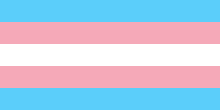Crossplay
| Cross-dressing |
|---|
| History of cross-dressing |
| Key elements |
| Modern drag culture |
| Sexual aspects |
|
Sexual attraction to cross-dressers |
| Other aspects |
| Passing as male |
| Passing as female |
| Organizations |
| Books |
Crossplay (the term is a portmanteau of crossdressing and cosplay) is a type of cosplay in which the person dresses up as a character of a different gender. Crossplay's origins lie in the anime convention circuit, though, like cosplay, it has not remained exclusive to the genre.
Female-to-male crossplay
In most countries that play host to hobbyists who would call themselves cosplayers, female-to-male crossplayers (females costumed as male characters, sometimes abbreviated "FtM") are far more common, due to a variety of social and cultural factors.[1]
Many (or even most) females will crossplay for the same reasons that they would cosplay – because they like the character and/or the costume, and wish to represent that. In Japan, female costumers tend to dominate (in numbers) the field of cosplay in general, often portraying a huge assortment of colorful characters regardless of gender.
As bishōnen are portrayed in manga and anime as liminal beings, it is considered "easier" for a female to cross-play as a bishōnen than it would be for her to crossplay as a male character from a Western series.[2]
- Social stigma
In some countries, FtM crossplayers do not catch the public eye as any stranger than their non-crossplay counterparts. However, in yet other countries, there is a social stigma attached to FtM crossplay: some, particularly those outside the cosplay community, suspect FtM crossplayers as having penis envy, being transgender, or having a lesbian sexual orientation. On the other hand, within the cosplay community, there is very little stigma attached to FtM.
In contrast to some of these social stigmas, most females who crossplay are not actually homosexual or transgender and simply enjoy the art of dressing up as their favorite character. For these crossplayers, it is no different from an actress playing a male role.
Male-to-female crossplay
| Part of a series on |
| Transgender topics |
|---|
 |
| Identities |
| Topics |
| Attitudes |
| Legal issues |
| Lists |
|
|
Male-to-female crossplayers, (males costumed as female characters, sometimes abbreviated "MtF"), are somewhat more common outside Japan. Originally, in America, a popular anime series for MtF crossplayers was Sailor Moon, creating "humorous effect and social levity".[3] Due largely to the nature of most costumes from the series (skintight tops and impossibly short skirts), this led to a negative stereotype which still exists both inside and outside of the anime community: that of the overweight, hairy-legged Sailor Soldier. This extremely derogatory stereotype has been frequently parodied, sometimes through intentionally ironic genderplay crossplay. "Sailor Bubba" (a staple of Anime Central, further enshrined as a bobble-head doll) and Man-Faye are primary examples of this.
In recent years, however, anime conventions have seen an increase in the number of Male to Female crossplayers who put a formidable amount of preparation and effort into the ruse of a female persona. Some males, particularly teenagers, frequently manage to recreate a striking image of femininity that can fool most unsuspecting bystanders.
Male to Female crossplay is typically divided quite definitively into these two groups: those engaging in genderplay, and those attempting to pass as female. The stark contrast between these two groups is due largely to the social context surrounding the subject of male crossdressing. For most males, dressing in women's clothing is not something to be taken lightly, and so most crossplayers choose either to take the approach of ironic humor (intentionally not passing), or that of the masquerade (attempting to pass).
- Social stigma
Though some frown upon MtF crossplay for an immensely wide gamut of different reasons, ranging from rigid gender expectations to homophobia, MtF crossplay has become surprisingly well-accepted amidst most convention communities. Within anime conventions, bystanders typically encourage MtF crossplay, although the ways in which they express this vary.
The majority of MtF crossplayers are neither homosexual nor transgender, though the ratio of homosexual and transgender individuals is slightly higher within MtF crossplayers than it is with the general male public. The anime convention community is largely seen as accepting of the blurring of gender roles, and as such, may encourage some male fans to experiment with unconventional gender roles, in ways which they might not attempt outside of the convention environment.
Genderplay crossplay
Genderplay crossplay is a costumed gender performance which plays with or parodies traditional gender roles, perceptions and issues by intentionally presenting a confusing gender identity.
The term genderplay crossplay could also be correctly called genderfuck crossplay, but due to the large number of minors involved in crossplay there is a consensus to use this more acceptable term.
In the cosplay convention community there are a few rare individuals with majority media coverage who often misrepresent the general crossplay community by exhibiting an overemphasis on genderplay.
See also
- Mana – figurehead of Japan's Gothic Lolita fashion movement.
- Cross-dressing
- Gender bender
References
- ↑ Palmer, Ada (March 29, 2007). "Let's Cosplay: Crossplay". TokyoPop. Retrieved 2007-04-18.
- ↑ Craig Norris; Jason Bainbridge (April 2009). "Selling Otaku? Mapping the Relationship between Industry and Fandom in the Australian Cosplay Scene". Intersections: Gender and Sexuality in Asia and the Pacific.
- ↑ Theresa Winge (2006). "Costuming the Imagination: Origins of Anime and Manga Cosplay". 1: 65-76. doi:10.1353/mec.0.0084.
External links
| Wikimedia Commons has media related to Crossplay. |
- An article about Crossplay on TokyoPop's website
- "Sailor Bubba," recognized by a popular amateur convention journalist
- BBC story on cosplay and conventions (RealVideo)